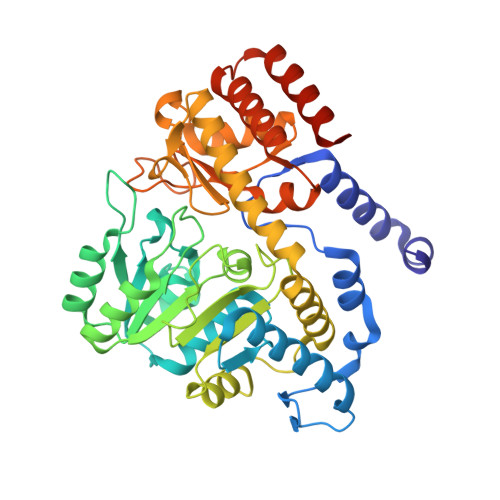Role of Lys-226 in the Catalytic Mechanism of Bacillus Stearothermophilus Serine Hydroxymethyltransferase-Crystal Structure and Kinetic Studies
Bhavani, S., Trivedi, V., Jala, V.R., Subramanya, H.S., Kaul, P., Purnima, K., Prakash, V., Appaji, R.N., Savithri, H.S.(2005) Biochemistry 44: 6929-6937
- PubMed: 15865438
- DOI: https://doi.org/10.1021/bi047800x
- Primary Citation of Related Structures:
1YJS, 1YJY, 1YJZ - PubMed Abstract:
Serine hydroxymethyltransferase (SHMT), a pyridoxal 5'-phosphate (PLP)-dependent enzyme catalyzes the reversible conversion of l-Ser and tetrahydropteroylglutamate (H(4)PteGlu) to Gly and 5,10-methylene tetrahydropteroylglutamate (CH(2)-H(4)PteGlu). Biochemical and structural studies on this enzyme have implicated several residues in the catalytic mechanism, one of them being the active site lysine, which anchors PLP. It has been proposed that this residue is crucial for product expulsion. However, in other PLP-dependent enzymes, the corresponding residue has been implicated in the proton abstraction step of catalysis. In the present investigation, Lys-226 of Bacillus stearothermophilus SHMT (bsSHMT) was mutated to Met and Gln to evaluate the role of this residue in catalysis. The mutant enzymes contained 1 mol of PLP per mol of subunit suggesting that Schiff base formation with lysine is not essential for PLP binding. The 3D structure of the mutant enzymes revealed that PLP was bound at the active site in an orientation different from that of the wild-type enzyme. In the presence of substrate, the PLP ring was in an orientation superimposable with that of the external aldimine complex of wild-type enzyme. However, the mutant enzymes were inactive, and the kinetic analysis of the different steps of catalysis revealed that there was a drastic reduction in the rate of formation of the quinonoid intermediate. Analysis of these results along with the crystal structures suggested that K-226 is responsible for flipping of PLP from one orientation to another which is crucial for H(4)PteGlu-dependent Calpha-Cbeta bond cleavage of l-Ser.
Organizational Affiliation:
Department of Biochemistry, Indian Institute of Science, Bangalore, India.
















